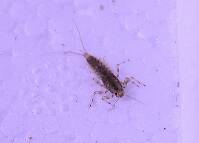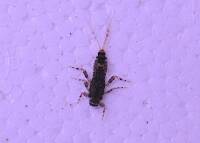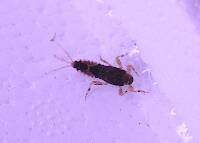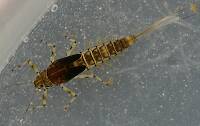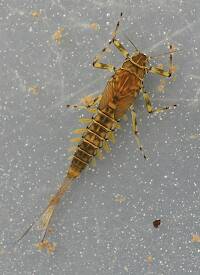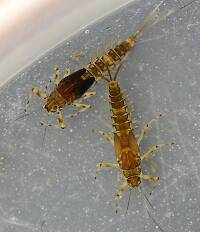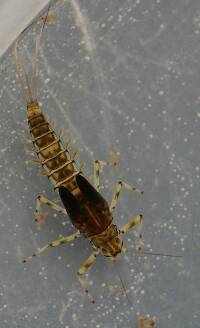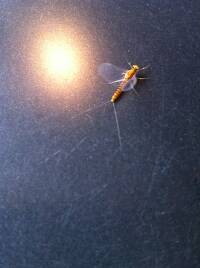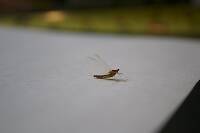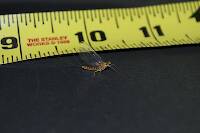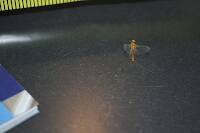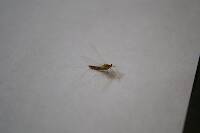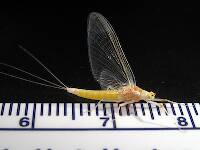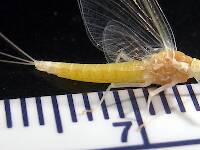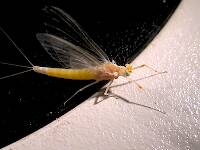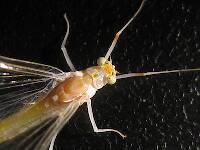
Hex Mayflies
Hexagenia limbata
The famous nocturnal Hex hatch of the Midwest (and a few other lucky locations) stirs to the surface mythically large brown trout that only touch streamers for the rest of the year.
Featured on the forum

Troutnut is a project started in 2003 by salmonid ecologist Jason "Troutnut" Neuswanger to help anglers and
fly tyers unabashedly embrace the entomological side of the sport. Learn more about Troutnut or
support the project for an enhanced experience here.
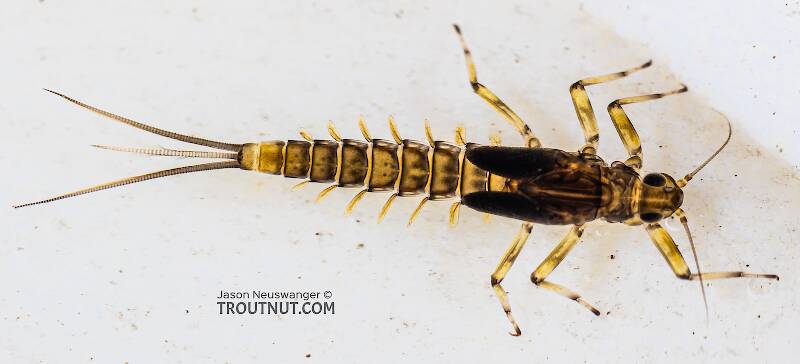
A nymph of the same species as this one emerged into a dun in my studio so I got photos of both stages.
NOTE: I missed an important key characteristic the first time I tried to identify this one (robust setae on the abdominal sternites, which were harder to see than I expected but are clearly present), so I went on a bit of a wild goose chase and landed at a dead end. After spotting that characteristic, this one keys more straightforwardly to either Baetis tricaudatus or the Baetis piscatoris complex. It doesn't seem to be a perfect fit for either one in the key, but I'm going with tricaudatus based on range and abundance. It's not certain.
However, I'm leaving the flawed analysis below with this disclaimer, because some aspects of how I approached that dead end might be informative in the future.
----Incorrect analysis below----
After spending a lot of time with this one under my shiny new microscope, I'm still not quite sure what it is. I botched my attempt to expose the mouth parts that might make the ID more definitive. Based on the key in Webb et al 2018's "Baetis Larvae of North America," here's my reasoning at each key couplet.
Couplet 1. The pronotum lacks dark, submedian U-shaped markings. Also, if I were to follow through to couplet 2, there seem to be characteristics that rule out each of the options: the intercalaris complex is ruled out by the abdominal markings, and the caudal filaments have neither a dark median band (ruling out the flavistriga complex) nor uniform pale coloration (ruling out Baetis notos). This sends me with decent confidence to couplet 4.
Couplet 4. I cannot find robust setae in my microscope on the scapes, pedicels, paraprocts, or sterna. I also do not see a pair of dark, bilobed markings on the pronotum. Unless I overlooked these characteristics, proceed to couplet 9.
Couplet 9. Abdominal tergum 5 is a bit paler than adjacent terga, but "distinctly paler"? The figure for Baetis alius in the paper, as well as a very nice picture posted by Millcreek in the forum here, shows that Baetis alius would have darker tergites surrounding #5. So proceed to couplet 11.
Couplet 11. The length of the gills is obviously less than 2X their width. This leads to the Baetis vernus complex, which could include that species or Baetis brunneicolor. This key doesn't say how to tell those species apart.
Switching over to Burien et al 2018 as the source, the characteristics used to distinguish vernus from brunneicolor seem to rule out either one. Brunneicolor should have more uniformly brown abdominal tergites, whereas vernus should have a lack of visible tracheation in most of the gills.
The fore femur length is about 3.8x its width.
Also worth noting: In the genus ID, I thought I could see the villipore in my microscope, but I'm not sure. If I back out of Baetis altogether and assume there's no villipore, I end up at Fallceon, but this specimen doesn't seem to have the frontal keel on the head that's supposed to be present on Fallceon quilleri. So that seems like a dead end as well.
NOTE: I missed an important key characteristic the first time I tried to identify this one (robust setae on the abdominal sternites, which were harder to see than I expected but are clearly present), so I went on a bit of a wild goose chase and landed at a dead end. After spotting that characteristic, this one keys more straightforwardly to either Baetis tricaudatus or the Baetis piscatoris complex. It doesn't seem to be a perfect fit for either one in the key, but I'm going with tricaudatus based on range and abundance. It's not certain.
However, I'm leaving the flawed analysis below with this disclaimer, because some aspects of how I approached that dead end might be informative in the future.
----Incorrect analysis below----
After spending a lot of time with this one under my shiny new microscope, I'm still not quite sure what it is. I botched my attempt to expose the mouth parts that might make the ID more definitive. Based on the key in Webb et al 2018's "Baetis Larvae of North America," here's my reasoning at each key couplet.
Couplet 1. The pronotum lacks dark, submedian U-shaped markings. Also, if I were to follow through to couplet 2, there seem to be characteristics that rule out each of the options: the intercalaris complex is ruled out by the abdominal markings, and the caudal filaments have neither a dark median band (ruling out the flavistriga complex) nor uniform pale coloration (ruling out Baetis notos). This sends me with decent confidence to couplet 4.
Couplet 4. I cannot find robust setae in my microscope on the scapes, pedicels, paraprocts, or sterna. I also do not see a pair of dark, bilobed markings on the pronotum. Unless I overlooked these characteristics, proceed to couplet 9.
Couplet 9. Abdominal tergum 5 is a bit paler than adjacent terga, but "distinctly paler"? The figure for Baetis alius in the paper, as well as a very nice picture posted by Millcreek in the forum here, shows that Baetis alius would have darker tergites surrounding #5. So proceed to couplet 11.
Couplet 11. The length of the gills is obviously less than 2X their width. This leads to the Baetis vernus complex, which could include that species or Baetis brunneicolor. This key doesn't say how to tell those species apart.
Switching over to Burien et al 2018 as the source, the characteristics used to distinguish vernus from brunneicolor seem to rule out either one. Brunneicolor should have more uniformly brown abdominal tergites, whereas vernus should have a lack of visible tracheation in most of the gills.
The fore femur length is about 3.8x its width.
Also worth noting: In the genus ID, I thought I could see the villipore in my microscope, but I'm not sure. If I back out of Baetis altogether and assume there's no villipore, I end up at Fallceon, but this specimen doesn't seem to have the frontal keel on the head that's supposed to be present on Fallceon quilleri. So that seems like a dead end as well.
Troutnut on Nov 10, 2020November 10th, 2020, 2:32 pm EST
I just added several microscope photos to this specimen and placed in the description my thoughts as I tried to key it out, but I ran into a dead end. Anyone have new insights?
Jason Neuswanger, Ph.D.
Troutnut and salmonid ecologist
Troutnut and salmonid ecologist
Millcreek on Nov 11, 2020November 11th, 2020, 1:10 am EST
First thought,Baetis tricaudatus. No real reason, just overall gestalt. There's another key by Webb, Jacobus and Sullivan. I haven't had time to go through it yet, but it looks pretty good overall.
You can download it here:https://www.mapress.com/j/zt/article/view/zootaxa.4394.1.6/0
Actually, you can't. Type in a google search for state of systematics of north american baetis. Go to Researchgate. you can get the pdf for free.
You can download it here:https://www.mapress.com/j/zt/article/view/zootaxa.4394.1.6/0
Actually, you can't. Type in a google search for state of systematics of north american baetis. Go to Researchgate. you can get the pdf for free.
"If we knew what it was we were doing, it would not be called research, would it?"
-Albert Einstein
-Albert Einstein
Troutnut on Nov 12, 2020November 12th, 2020, 6:27 am EST
Thanks Mark. I think your sense of the gestalt was probably right.
I've updated the description of this specimen after taking another look with the new microscope and noticing robust setae on the sternites (hard to see!). I think tricaudatus is the most likely, so I'm tentatively putting it there. The length:width ratio of the femora doesn't seem to match the key characteristics for tricaudatus, but it doesn't seem like a great match for the piscatoris complex either.
I've updated the description of this specimen after taking another look with the new microscope and noticing robust setae on the sternites (hard to see!). I think tricaudatus is the most likely, so I'm tentatively putting it there. The length:width ratio of the femora doesn't seem to match the key characteristics for tricaudatus, but it doesn't seem like a great match for the piscatoris complex either.
Jason Neuswanger, Ph.D.
Troutnut and salmonid ecologist
Troutnut and salmonid ecologist
Quick Reply
Related Discussions
Topic
Replies
Last Reply
0
Nov 6, 2020
by Troutnut
by Troutnut
12
Nov 12, 2020
by Millcreek
by Millcreek
0
Jul 30, 2019
by Troutnut
by Troutnut
3
Sep 14, 2010
by Jmd123
by Jmd123




